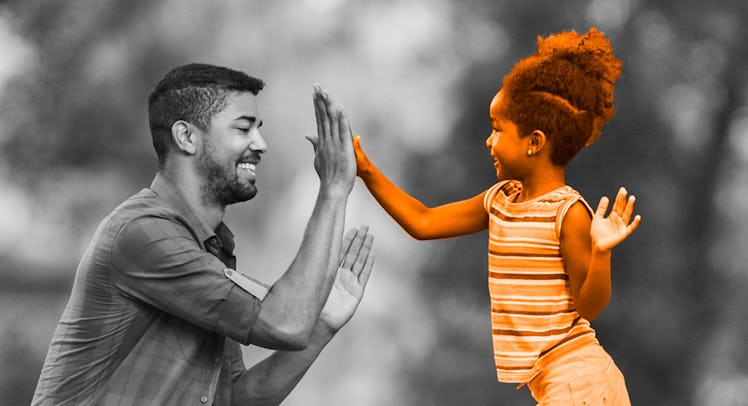How to Use Patty-Cake and Miss Mary Mack to Teach Rhythm
Teaching your child to move with the music does more than make them a phenom on the dance floor — it can help their language and social skills as well.

Baby music isn’t known for its beat. What’s odd about that is baby songs like “Patty-Cake” and “Miss Mary Mack” have strong rhythms. And that’s really the point. Those songs are important for teaching rhythm, which is helpful in all sorts of ways. The pattern recognition inherent in rhythm can help kids be better athletes, better observers, and better learners. And it just so happens that exercises teaching rhythm can also help with language fluency and reading, two other key life skills for young kids to develop.
But, like any motor skill, rhythm needs to be cultivated and developed. That’s where quick-step exercises come in.
“If you play a drum on a beat, the kid has to put their feet on the beat, and if the drum stops, you stop. It’s as simple as that,” says Terry Iacarino, a Baltimore County public school music teacher. “Get them to move, and see if they can make it silly and keep it on the beat. It also helps with balance, which is really good for a young child. So basically it’s a stop and go game — kind of like a freeze game — with a beat to it.”
Tips for Teaching Rhythm
- Keep it simple. Sometimes all a kid needs to do is practice putting a foot down when they hear a drum beat.
- Clapping games like “Patty-Cake” and “Miss Mary Mack” can help a child learn rhythm cooperatively.
- Get their whole body into rhythm practice. Jumping or moving to a beat can help too.
- Add language. The rhythm of words and rhymes will help connect the body to the beat.
- Add musical instruments like drums and xylophones as fine motor skills develop
It won’t happen overnight — like any skill, it takes practice. It might take a few weeks for kids to grab the beat. But it’s ultimately a fun way to get the whole family moving.
Clapping is a pretty fundamental method of setting or keeping a rhythm, and so clapping games are a good way to develop that skill. Again, “Patty-Cake” and “Miss Mary Mack” are perennial favorites, but games can also incorporate toys and an element of sharing, according to Iacarino, who has a favorite of her own. “Sit on the floor in a circle, and tap the floor four times,” suggests Iacarino. “Have a little something to pass — a bean bag or a small toy.” As the children tap, they say a rhyme: “One-two-three-four put it on your neighbor’s floor.” On the phrase “neighbor’s floor,” the kids pass an object in one direction. If there are enough objects for everyone, they might receive one from the other side. The game progresses in a loop.
Miranda Taylor, a dance instructor at Perna Dance Center in Hazlet, New Jersey, and the drummer for the band Exmaid, also sees a benefit to helping kids practice rhythm, particularly in cooperation and listening.
“It’s really hard for little kids to jump and all land at the same time,” explains Taylor. “We practice something called a sauté. It’s just jumping up and down. So we’ll do eight jumps and then seven claps. We’ll jump 1-2-3-4-5-6-7-8, and then we’ll stop jumping and just clap our hands on the beat seven times. And we’ll do that in two groups, so one group can jump while the other group claps. They can feel it with different parts of their body and actually listen to the beat. Because when you are talking about learning how to be more rhythmic, it’s about listening to what is going on. It helps them hear it and feel it in different ways, and that usually helps it sink in a little better.”
Kids with some finer motor skills can graduate to keeping the time on a drum or xylophone. It requires hand-eye coordination, aim, restraint, timing, and motor planning.
“I feel like with drumming it’s about a different kind of coordination — it’s a little more specific: your hand does this, your foot does this, it’s not like your core is moving,” says Taylor. “There’s no locomotion, but the idea of what comes between two beats is very important to me. I think that is really important in both dance and drum, because learning how to be accurate is about learning how much time you have in between two beats.”